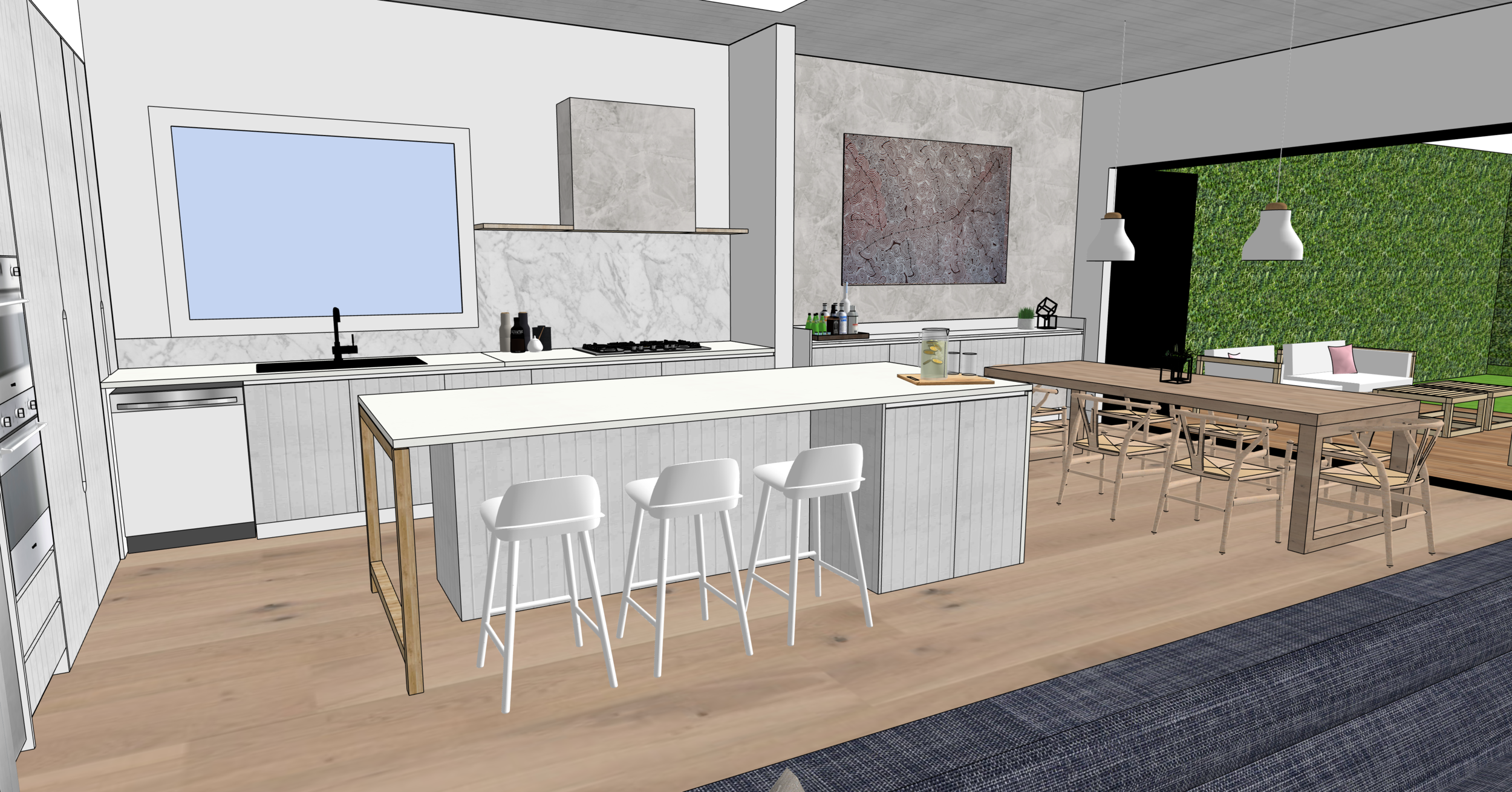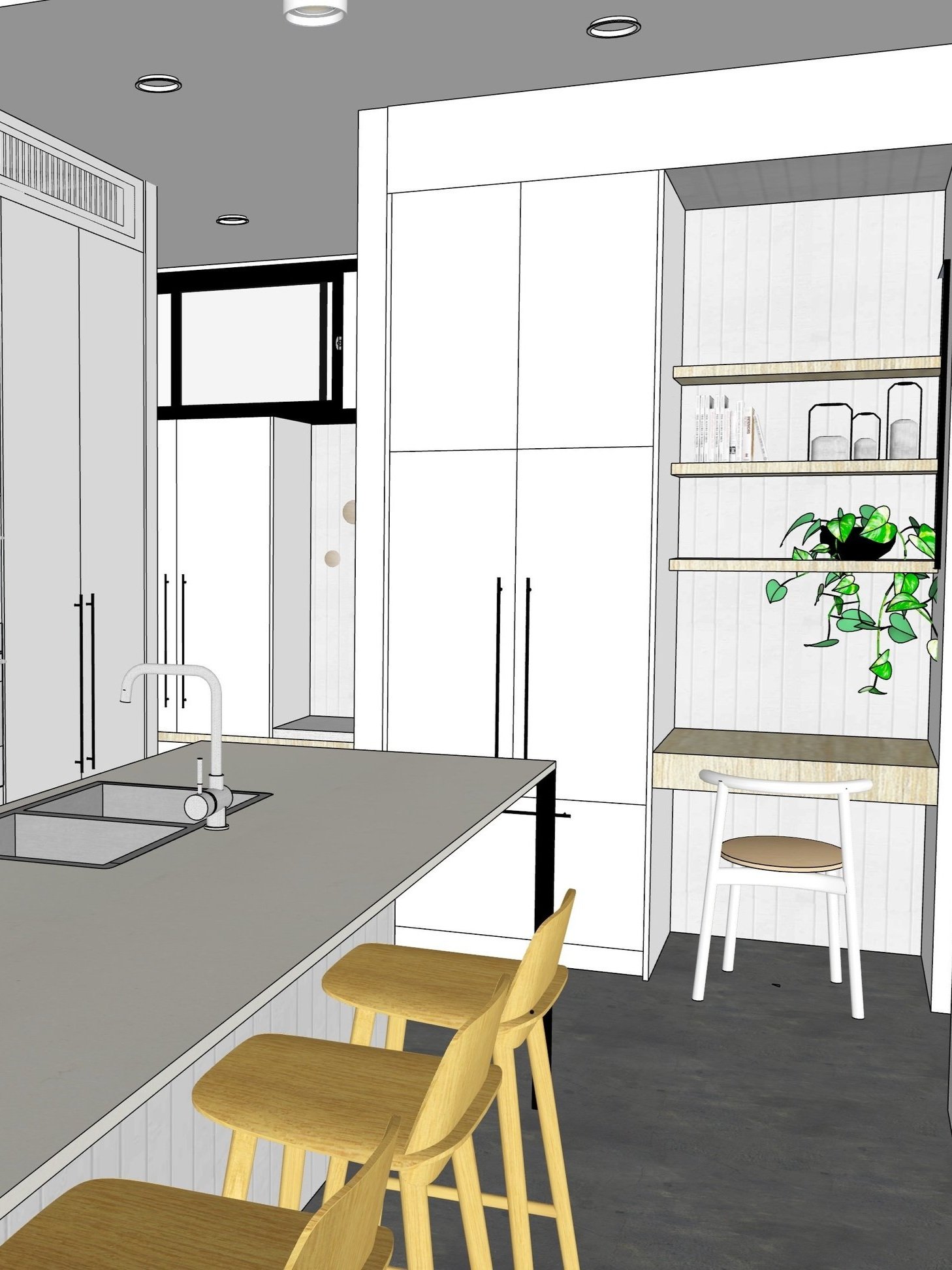Bench top and Counter top materials: pros and cons
When it comes to selecting the right bench top (countertop) material for an interior design project, the array of choices can be overwhelming. Each option brings its own unique set of advantages and drawbacks, making the decision challenging!!
In this post I share some information plus the pros and cons of three of the most popular products on the market; engineered stone, natural stone and porcelain panels.
Hopefully this will help you make an informed choice in your next design project :)
1: Engineered stone
Engineered stone is a man-made, composite material that is created by binding together crushed stone using a specific type of adhesive.
Engineered stone is one of the most popular and versatile bench top materials. This is a man-made composite created by combining crushed stone (typically quartz) with a specific adhesive or resin binder. This innovative fusion results in a highly durable and aesthetically appealing surface that can closely mimic the appearance of natural stone (while offering benefits that natural stone doesn’t have).
Engineered stone is incredibly strong and resistant to scratches, stains and heat, making them an excellent choice for high-traffic areas like kitchens and bathrooms.
Unlike natural stone, engineered stone isn’t porous, which means it doesn’t require sealing and is less likely to attract bacteria or absorb liquids. This makes it a hygienic and easy-to-clean surface.
As a manufactured product, engineered stone also offers greater consistency in terms of pattern and colour, allowing for a uniform look.
One downside of engineer stone is regarding heat resistance. While engineered stone is heat resistant, it’s not entirely heat proof. So prolonged exposure to high temperatures or direct contact with hot cookware can cause discolouration or damage.
Also, despite its natural appearance, engineered stone is not the same as genuine natural stone and some homeowners or designers definitely prefer the authenticity and unique characteristics of natural materials.
Example brands: Caesarstone, Smartstone, Quantum Quartz, Silestone, Dekton, Corian
Caesarstone Fresh Concrete in project by The Little Design Corner
PROS:
Can be more affordable than real stone (but not always!)
Quite strong and durable
Flexible thicknesses
Heat and stain resistant (but not heat/stain proof)
Good consistency in colour as it is made to a 'recipe' of sorts
Lots of colour options
Easy to keep clean (not as porous as natural stone)
CONS:
Set slab sizes - normally to a maximum of around 3m wide (some companies do larger slabs)
Is more porous than people often think - does stain if liquid left on too long
Can chip easily
Not all products are UV stable - many will discolour with exposure to sunlight
Not often suitable for outdoors (some companies now offer exterior options)
Not all products are suitable as splash backs (check with manufacturer)
Linked to some significant health problems for installers
2: Natural stone
Natural stone is a piece of naturally formed stone that is cut and shaped to the size that you need for your project.
Natural stone is a timeless choice for bench tops and bring a bit more character and authenticity to spaces (often feel more high-end as well).
Many types of natural stone (e.g. granite) are incredibly durable and resistant to scratches, which makes them a great choice for high traffic areas. Quite a few (e.g. granite and soapstone) can also withstand high temperatures, making them suitable for kitchen countertops where hot pots and pans may come in direct contact with the surface.
Having said that, some natural stone options (e.g. marble) can be very expensive and also be hard to care for. For example many options are very porous and may require periodic sealing to prevent staining and bacteria growth. Materials like marble and limestone are also very prone to staining (due to their porous nature) and this makes them difficult to take care of where spills occur.
But many home owners love the look of natural stone and are happy to use it, despite the fact it can be hard to look after.
Examples: Marble, Limestone, Granite, Travertine, Sandstone, Slate, Soapstone, Dolomite
Marble in small kitchen by The Little Design Corner
PROS:
Beautiful, natural product that comes in all different types of colours and finishes
One of a kind - unique piece specifically for your project
Stain, scratch and chip resistant - some softer and more porous than others
Wide price ranges
Different finishes available - e.g. polished, honed or brushed.
The harder the stone, the more resistant it is to abrasion.
Can often get large slab sizes
CONS:
Porous - easily absorbs liquids (acids and red wine are particularly problematic!). Often the more expensive the stone - the softer and more porous it can be!
Can be prone to scratching and staining
Normally needs to be sealed before use
Can be very expensive
Non-renewable resource (not particularly environmentally friendly)
3: Porcelain
Porcelain panels are becoming an increasingly popular choice for bench tops and are manufactured from pressed natural materials like clay, feldspar, and other minerals.
This all natural product is free from harsh chemicals or binders, making it an environmentally friendly and sustainable option for your interior design projects.
Porcelain panels are highly durable and resistant to scratches, stains and heat so this makes them a great option, even in high traffic areas (or homes with children!!). Due to their non porous nature, porcelain bench tops are easy to clean and do not require sealing. They are produced in a wide variety of colours, patterns, and finishes, including designs that mimic natural stone or other materials - like you can see in the marble look porcelain in the project below.
Compared to natural stone, porcelain panels are also relatively lightweight, which makes them easier to handle and install and unlike some other materials, porcelain is resistant to UV rays, so can be used outside or in places that are exposed to direct sunlight.
Porcelain panel as backsplash in project by The Little Design Corner
PROS:
Comes in large slab sizes but are lightweight, so easier to install and work with
Very realistic finishes - e.g can be hard to tell the difference between real marble and porcelain if you're not an expert
Strong and easy to care for - doesn't stain or scratch
Good for outdoor areas and is UV stable so won't discolour over time
Stain resistant
Limitless application options due to being lightweight
CONS:
Need a stone mason who is used to dealing with the material (this is becoming easier now due to the increasing popularity of the product)
Can be pricey - prices are normally comparable to higher end options in engineered stone ranges (although there are some less expensive options coming on to the market).
Fragile - while porcelain is durable once installed, it can be brittle and prone to chipping or cracking during the fabrication and installation process.
Limited edge options - due to their thin profile porcelain may have limited edge design options compared to other materials like natural or engineered stone.
The world of benchtop/counter top choices can be overwhelming if you don’t really know much about what you’re choosing between. So I hope this has helped give you a bit more information so you can make an informed choice for your clients :)
Enjoy the rest of your day!
Clare x
Dr Clare Le Roy
Learn SketchUp with our fun online course for beginners…
If you want improve your work with design clients or you are about to start renovating or remodeling then you will love SketchUp.
With this software you can mock up an entire home in 2D (floor plans, joinery/millwork elevations, lighting and electrical plans and more) and 3D (renderings and perspective drawings) so you can picture exactly what it will look like when it is finished plus prepare your technical drawings for use with your clients, trades and contractors.
Learning SketchUp will save you time, money, mistakes and so much more! It is a well known piece of software in the interior design and architecture industries and will give you a solid technical drawing skill that will immediately upgrade the professionalism of the work you are doing.
I teach an online course for beginners that is focused specifically on using SketchUp for interior design purposes. We have had more than 10,000 students come through the course with so many fantastic projects designed and built!
We have all sorts of students in the course including designers and architects, cabinet makers, home renovators/remodelers, kitchen and bathroom designers, event planners, landscape designers and design enthusiasts.
To find out more about the courses we have on offer click the link below. And reach out if you have any questions I can help with :)











